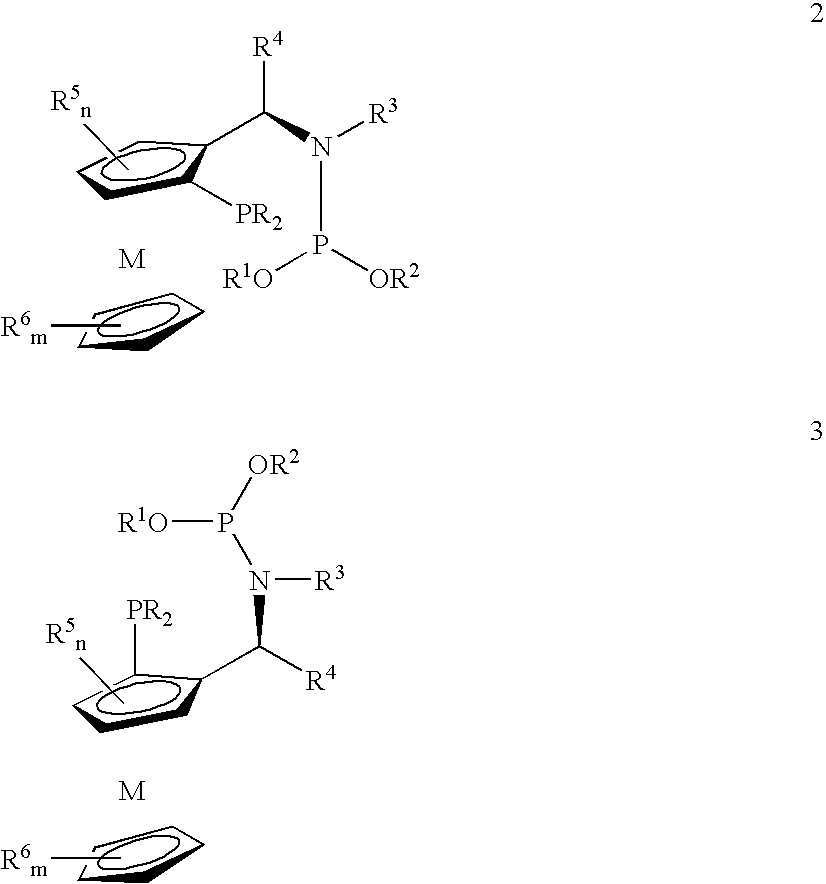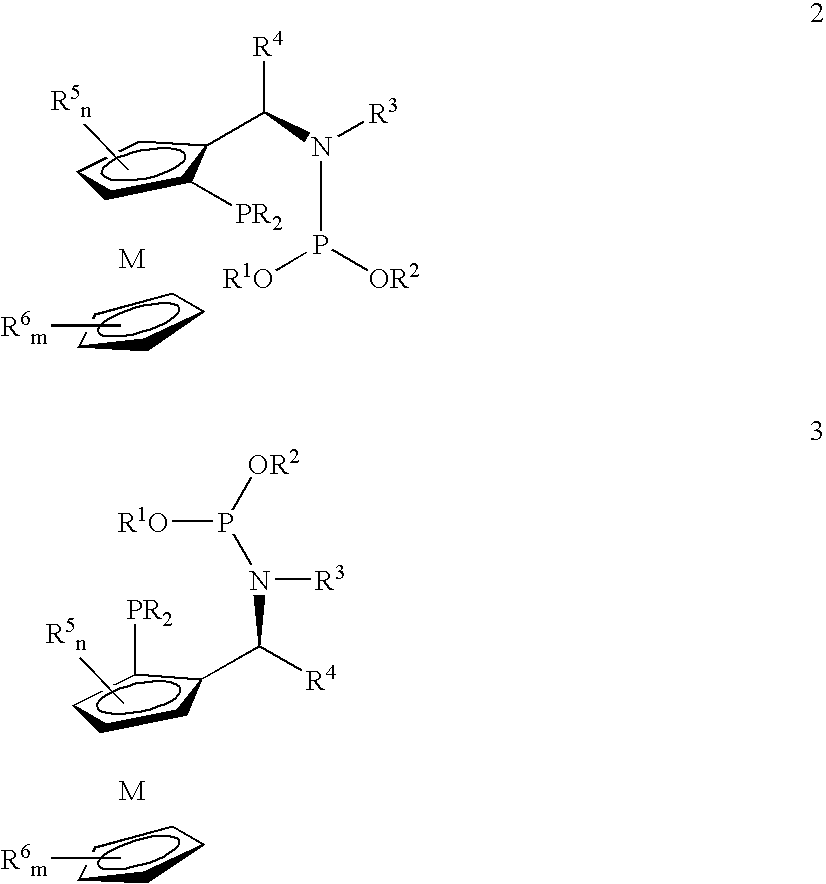Phosphine-phosphoramidite compounds
a technology of phosphine and phosphoramidite, which is applied in the direction of organic compounds/hydrides/coordination complex catalysts, organic compounds/chemical process catalysts, organic compounds/chemical complex catalysts, etc., can solve the problems of difficult production and therefore high cos
- Summary
- Abstract
- Description
- Claims
- Application Information
AI Technical Summary
Benefits of technology
Problems solved by technology
Method used
Image
Examples
example 1
Preparation of (R)-N-diphenoxyphosphino-N-methyl-1-[(S)-2-(diphenylphosphino)ferrocenyl]ethylamine (2a)
[0052]Toluene (5 mL) was added to a 100-mL 3-necked flask which was cooled to below −70° C. in a dry ice-acetone bath. Phosphorus trichloride (0.26 mL; 3.0 mmol; 1.0 equiv) was added followed by triethylamine (0.50 mL; 3.6 mmol; 1.2 equiv). (R)-N-Methyl-1-[(S)-2-(diphenylphosphino)ferrocenyl]ethylamine (4a)(1.28 g; 3.0 mmol) dissolved in 15 mL of toluene was added dropwise such that the temperature remained below −50° C. The reaction mixture was stirred in dry ice-acetone for 1 hour, then allowed to warm to ambient temperature over 1 h and stirred at ambient temperature for 2 hours. The reaction mixture was cooled to below −70° C. and triethylamine (1.05 mL; 7.7 mmol; 2.5 equiv) was added followed by phenol (565 mg; 6.0 mmol; 2 equiv) in 10 mL of toluene. The reaction mixture was allowed to warm to ambient temperature overnight to completely consume 4a according to thin layer chrom...
example 2
Preparation of (R)-N-[bis(4-methoxyphenoxy)phosphino]-N-methyl-1-[(S)-2-(diphenylphosphino)ferrocenyl]ethylamine (2b)
[0054]Toluene (5 mL) was added to a 100-mL 3-necked flask which was cooled to <5° C. in an ice-water bath. Phosphorus trichloride (0.26 mL; 3.0 mmol; 1.0 equiv) was added followed by triethylamine (0.50 mL; 3.6 mmol; 1.2 equiv). (R)-N-Methyl-1-[(S)-2-(diphenylphosphino)ferrocenyl]ethylamine (4a)(1.28 g; 3.0 mmol) dissolved in 15 mL of toluene was added dropwise such that the temperature remained below 15° C. The reaction mixture was stirred in ice-water for 15 minutes, then allowed to warm to ambient temperature for 45 minutes. The reaction mixture was cooled to <5° C. in ice-water and triethylamine (1.05 mL; 7.7 mmol; 2.5 equiv) was added followed by 4-methoxyphenol (745 mg; 6.0 mmol; 2 equiv) in 10 mL of toluene at a rate such that the temperature remained below 15° C. The reaction mixture was allowed to warm to ambient temperature overnight to almost completely con...
example 3
Preparation of (R)-N-[bis(4-trifluoromethylphenoxy)phosphino]-N-methyl-1-[(S)-2-(diphenylphosphino)ferrocenyl]ethylamine (2c)
[0056]Toluene (5 mL) was added to a 100-mL 3-necked flask which was cooled to <5° C. in an ice-water bath. Phosphorus trichloride (0.26 mL; 3.0 mmol; 1.0 equiv) was added followed by triethylamine (0.50 mL; 3.6 mmol; 1.2 equiv). (R)-N-Methyl-1-[(S)-2-(diphenylphosphino)ferrocenyl]ethylamine (4a)(1.28 g; 3.0 mmol) dissolved in 15 mL of toluene was added dropwise such that the temperature remained below 15° C. The reaction mixture was stirred in ice-water for 15 minutes, then allowed to warm to ambient temperature for 45 minutes. The reaction mixture was cooled to <5° C. in ice-water and triethylamine (1.05 mL; 7.7 mmol; 2.5 equiv) was added followed by 4-trifluoromethylphenol (973 mg; 6.0 mmol; 2 equiv) in 10 mL of toluene at a rate such that the temperature remained below 15° C. The reaction mixture was allowed to warm to ambient temperature overnight to almos...
PUM
| Property | Measurement | Unit |
|---|---|---|
| boiling point | aaaaa | aaaaa |
| temperature | aaaaa | aaaaa |
| pressure | aaaaa | aaaaa |
Abstract
Description
Claims
Application Information
 Login to View More
Login to View More - R&D
- Intellectual Property
- Life Sciences
- Materials
- Tech Scout
- Unparalleled Data Quality
- Higher Quality Content
- 60% Fewer Hallucinations
Browse by: Latest US Patents, China's latest patents, Technical Efficacy Thesaurus, Application Domain, Technology Topic, Popular Technical Reports.
© 2025 PatSnap. All rights reserved.Legal|Privacy policy|Modern Slavery Act Transparency Statement|Sitemap|About US| Contact US: help@patsnap.com



